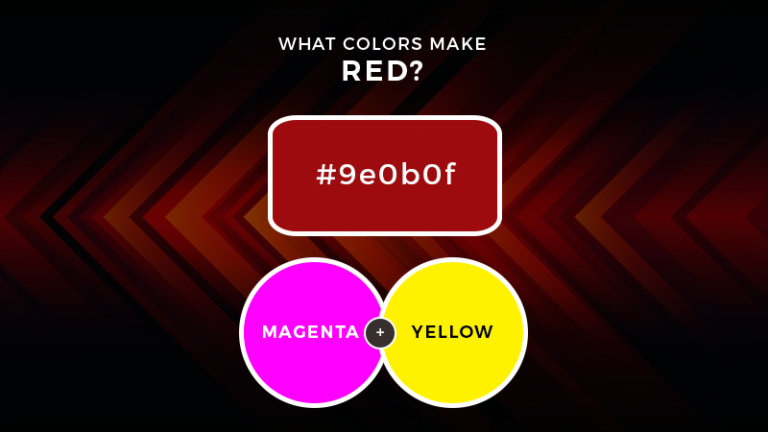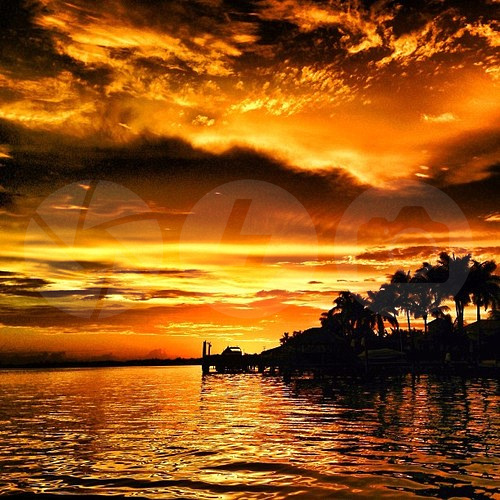The mixing of colored physical substances corresponds to subtractive color mixing, hence it corresponds to our intuition about mixing colors. To explain the mechanism, consider mixing red paint with yellow paint. The red paint is red because when the ambient light strikes it, the composition of the material is such that it absorbs all other colors in the visible spectrum except for red. The red light, not being absorbed, reflects off the paint, and is what we see. This same mechanism describes the color of material objects – note that light is not a material object – and so applies to the yellow paint as well. Making recourse to the figure above demonstrating additive color mixing, one sees that yellow light is composed of an mixture of red and green light.
When we mix the two paints, the resulting substance has red paint and yellow paint. The yellow paint absorbs all colors except for red and green. However, the red paint will absorb the green reflected by the yellow paint. The red paint can be said to subtract the green from the yellow paint. The resulting paint reflects only red light and so appears red to our eyes. This results in a darker and desaturated color compared to the color that would be achieved with ideal filters.
The three primary colors typically used in subtractive color mixing systems are cyan, magenta, and yellow, corresponding to the CMY color model and CMYK color model widely used in color printing. In subtractive mixing of color, the absence of color is white and the presence of all three primary colors makes a neutral dark gray or black. The secondary colors are the same as the primary colors from additive mixing and vice versa.
Subtractive mixing is used to create a variety of colors when printing or painting on paper or other white substrates, by combining a small number of ink or paint colors. Black can be approximated by mixing cyan, magenta, and yellow, although real pigments are not ideal and so pure black is nearly impossible to achieve. A cyan surface absorbs red, just as a magenta surface absorbs green, and a yellow surface absorbs blue. If you shine red light on a yellow surface, it will appear black.
You can make a surface appear any color in the visible spectrum by absorbing different amounts of red, green and blue with cyan, magenta, and yellow pigments. In the applet on the next page, you can play around with various mixtures of the three subtractive primary colors to make any color you want. Note that an equal mixture of the three primary subtractive colors absorbs red, green, and blue, and therefore appears black. However, this is not an effective way to print in black because you use a lot of ink and the final result often is grayish has a color cast.
That is why you also purchased a black cartridge separately. Note that modern printers do a very good job a recreating all the colors in a photograph with the three subtractive primaries and black. More demanding printing technologies use more pigments to be able to reproduce the original colors with even greater accuracy. Pigments are chemicals that absorb selective wavelengths—they prevent certain wavelengths of light from being transmitted or reflected. Because paints contain pigments, when white light shines on colored paint, only some of the wavelengths of light are reflected. For example, cyan paint absorbs red light but reflects blue and green light; yellow paint absorbs blue light but reflects red and green light.
If cyan paint is mixed with yellow paint, you see green paint because both red and blue light are absorbed and only green light is reflected. In contrast to an additive system, color systems that remove colors through absorption are called "subtractive" color systems. They are called this because the final color is achieved by starting with white light and then subtracting away certain colors, leaving other colors. Examples of subtractive color systems are paints, pigments, and inks.
An orange pumpkin that you see printed in a newspaper is not necessarily created by spraying orange ink on the paper. Rather, yellow ink and magenta ink are sprayed onto the paper. The yellow ink absorbs blue light and a little green and red from the white light beam, while the magenta ink absorbs green light and a little blue and red, leaving only orange to be reflected back.
Those names are already used as the primary colors for light..The primaries for pigments must be distinct to differentiate them from red and blue. We have a clear idea of a hue in our head when when say "red". Color names become less useful when they are used to describe a larger arc of color across the color wheel. It is easier for us all to envision the same color when we say cyan. Just as it would be confusing to describe red as an orangeish violet, describing cyan as a greenish shade of blue makes no sense .
Stop describing magenta as an off color of red. By convention, the three primary colors in additive mixing are red, green, and blue. In the absence of light of any color, the result is black. If all three primary colors of light are mixed in equal proportions, the result is neutral . When the red and green lights mix, the result is yellow.
When green and blue lights mix, the result is a blue. When the blue and red lights mix, the result is purple. In the subtractive color mixing demonstration, the same blue and yellow filters are both placed over a single beam of light. Three transparent protractors are overlaid on top of each other.
The protractors are colored cyan, magenta, and yellow. The three protractors are illuminated with white light, sometimes referred to as RGB light. Each protractor absorbs a single primary color of light. Where two protractors overlap, a single primary color of light shows through. For example, where the cyan and the yellow protractor overlap, the red and blue light are absorbed and the green light is seem shining through.
And where the cyan and the magenta protractor overlap, the red and green light are absorbed and the blue light is seem shining through. Finally, where the magenta and the yellow protractor overlap, the green and blue light are absorbed and the red light is seem shining through. This photo illustrates the principles of color subtraction. To begin, consider white light to consist of the three primary colors of light - red, green and blue. If white light is shining on a shirt, then red, green and blue light is shining on the shirt.
If the shirt absorbs blue light, then only red and green light will be reflected from the shirt. So while red, green and blue light shine upon the shirt, only red and green light will reflect from it. Red and green light striking your eye always gives the appearance of yellow; for this reason, the shirt will appear yellow. This discussion illustrates the process of color subtraction. The process is depicted visually by diagram at the right. Furthermore, the process is depicted in terms of an equation in the space below.
What Happens When You Mix Yellow Magenta And Cyan A simulated example of subtractive color mixing. An external source of illumination is assumed, and each primary attenuates some of that light. Combining all three primaries absorbs all the light, resulting in black. For real pigments, the results would be somewhat complicated by opacity and mixing behavior, and in practice adding a fourth pigment such as black may be helpful. The first thing you have to understand that red, blue and yellow are not complementary colors.
In additive color mixing red, blue and green are the scientific primaries, and as weird as it sounds, yellow is a secondary color of mixing red and green lights. This makes subtractive color mixing the "black" color theory. Mixing all three subtractive primaries produces a dark neutral, the opposite of white, because each paint subtracts or absorbs light that might be reflected by the other. Subtractive color mixtures can only be made lighter by diluting the amount of pigment in the mixture with white paint or water; either remedy weakens the color saturation. So subtractive mixture typically also reduces the hue purity in the color of mixed substances. When green and blue lights mix, the result is a cyan.
When the blue and red lights mix, the result is magenta. Color scientists diagram this connection between cone responses and perceived color using the trilinear mixing triangle devised by James Clerk Maxwell. This triangle defines the chromaticity of any unrelated color as a proportional mixture of the three cone outputs; the "white" brightness is approximately equal to their sum. These outputs, in turn, can be exactly reproduced by a specific mixture of three actual "primary" lights — typically red, green and blue violet.
All modern color models are based on additive trilinear values that specify both the chromaticity and luminance of a color. In fact, many late 19th and early 20th century artists learned the basics of color theory in terms of a mixing triangle — not a color wheel. When you're printing or painting, you start with white paper, and then have to take away colour by blocking the light, with your various paints and inks. For this, we use cyan, magenta and yellow because they are the polar opposites of the light colours red, green and blue. Cyan blocks red light, Magenta blocks green light, and Yellow blocks blue light.
Add as much as you can of all three, and you get black. Three colored spotlights - red, green and blue - illuminate a white screen. A hand is placed between the screen and the lights, thus casting overlapping shadows on the screen. From left to right, you will observe a yellow, magenta and cyan shadow.
The yellow shadow is produced by the blocking of the blue light; the red and green lights converge to produce yellow. The magenta shadow is produced by the blocking of the green light; red and blue lights converge to produce magenta. And finally, the cyan shadow is produced by the blocking of the red light; blue and green light converge to produce the cyan.
The colors red and blue are produced where the shadows overlap. The photo demonstrates principles of color subtraction and color addition. Yellow light shines on a sheet of paper containing a red pigment. Determine the appearance of the paper.Yellow light can be thought of as consisting of red light and green light. A red pigment is capable of absorbing cyan light.
That is, red paper can absorb both green and blue primary colors of light . So red and green light shine on the paper; and green light is subtracted. (There is no need to subtract blue light since blue light is not shining on the paper.) This leaves red light to be reflected.
If the paper reflects the red light, then the paper will look red. Average mixing is about getting an average color out of two colors. For example, black and white averages to gray, and blue and red averages to purple. In this case, there are 8 primary colors, white, cyan, magenta, yellow, red, green, blue, and black. The same considerations explain why the RGB additive primaries are effective only in light stimuli, such as televisions or computer monitors, but not in paints or inks.
There is no shared reflectance in the reflectance curves of red orange, green and blue violet paints, so these produce very dull, dark colors when mixed subtractively. The additive primaries are only effective when the mixing occurs in the retina. 3 shows subtractive color mixing using colored gels. Gels are subtractive because they stop certain wavelengths of light from passing through.
In essence, they absorb those colors and allow others to pass through. So we start with white light and pass that through a yellow filter. The yellow stops the blue and lets red and green pass through. Anyone who mixed red and green and blue poster paints at school will realise that you don't get nice bright colours that way.
This is because paint, like printing ink, doesn't generate light and make additive colours, instead it selectively reflects and absorbs wavelengths. The second point of difference with additive color mixing has to do with how the colors combine in subtractive mixtures. An example is shown below for two common paint colors, categorically labeled magenta and yellow.
It's handy to think of additive mixing as the "white" color theory. Mixing light wavelengths from the "red," "green" and "blue violet" parts of the spectrum adds luminosity and negates hue to shift the mixture color of lights from dim pure hues toward bright whites. The key principle is that the eye always adds together all the wavelengths of light incident on the retina — nothing is lost — and it is this total light sensation that the eye interprets as color.
Ever had a painting turn to mud when you try to mix colors? Conventional color theory using red, yellow and blue does not work. It will turn your pictures to mud and frustrate you as you struggle to mix colors that are impossible with this color triad. The same goes for the split primary system where you mix with a warm and cool version of each primary.
The split primary system works much better than just using the three primaries but it misses the point about how colors really mix and what the true primary colors are. Just ask your printer, Cyan, Yellow, and Magenta. Before you write me off as a heretic, read on, try a few simple color mixing experiments at home with your colored pencils watercolors, opaque paints and see for yourself.
By changing the way you think about primary colors, your ability to mix colors will improve overnight. There is a fundamental difference between color and pigment. Color represents energy radiated by a luminous object such as a cathode ray tube or a light-emitting diode . When you see a red area on a CRT, it looks red because it radiates a large amount of light in the red portion of the electromagnetic radiation spectrum , and much less at other wavelength. Pigments, as opposed to colors, represent energy that is not absorbed by a substance such as ink or paint.






















































